Award Holder: Patrick Jolicoeur
University: University of Glasgow
Title of Research: Cultural Contacts and Exchange of Metal in the Eastern Arctic AD 700-1300
Introduction
My doctoral research is attempting to understand the nature of metal use and exchange in the Arctic nearly more than 1000 years ago. The Eastern Arctic, comprising the Canadian Arctic and Greenland, nearly 1500 years ago was a place of tremendous change. In particular, the Dorset culture, an archaeological culture named after Cape Dorset on Baffin Island, are assumed to be the only people living in the Arctic at this time. Archaeologists break up the nearly 1500 year period of Dorset existence into three main components (or periods) intuitively named the Early, Middle, and Late Dorset. While there is ongoing debate regarding the validity of the distinction between the former two groups (see Ryan 2016), the Late Dorset (AD 500-1300) are thought to be, in many ways, a class of their own. While undoubtedly the connection between the Late Dorset and their ancestors is clear, there are a number of features that make them unique such as a reoccupation of the High Arctic (a region that was effectively uninhabited for nearly 500 years), the widespread construction of a large communal longhouses, a proliferation of artistic expression, and, most relevant to this report, the beginnings of widespread metal use. Despite the supposed use of metal, there are very few metal artefacts that have been recovered from Late Dorset sites. The most notable exceptions being found in the High Arctic (Schledermann 1991) and the Central Arctic (LeMoine et al. 2003). While ongoing fieldwork by other researchers (Grønnow et al. 2014; Jensen et al. 2015) has the potential to increase the assemblage of recovered Late Dorset metal objects, it has largely been left to an often-cited but largely untested belief that the lack of metal is the result of poor preservation due to acidic Arctic soils and curation on part of the Late Dorset of the metal objects that they did use (McCartney 1991). While data analysis is ongoing and the conclusions reached in this summary may change, a brief overview of my work so far will be given.
Past Approaches
Past approaches to Arctic and Sub-Arctic metal use has been usefully summarised by Cooper (2016). Much of the earliest work in understanding metal use among Arctic peoples was conducted by Franklin et al. (1981) and McCartney (1991). Importantly, their work focused primarily on metal tools themselves from mainly pre-contact Inuit (referred to as the “Thule” by most archaeologists) but also from Late Dorset (and earlier) contexts. In saying that, McCartney (1991) proposed that the existing assemblage of metal tools is far smaller than what may have been used, mainly due to the reasons cited above. He proposed analysing blade slot widths in organic tools (e.g. harpoon heads or knife handles) might be a useful approach for making up this gap in the archaeological record (McCartney 1991). In general, the logic behind this assumption is that chert or ground slate blades generally cannot be thinner than a few millimeters (McCartney hypothesised 2mm) while metal blades can. While some have researched metal use among Inuit archaeological collections, which will be detailed below, far fewer attempts have been made at understanding Late Dorset metal use.
There are two published studies that most closely resemble the work that I carried out. First, Gullason (1999) recorded blade slot measurements from a number of late pre-contact and early post-contact Inuit harpoon heads and demonstrated that metal use was more prevalent in Inuit sites that predate the 16th century (i.e. the first wave of substantial post-Norse European contact). Her data demonstrate that simply measuring the width of a blade slot does not necessarily correlate to the raw material of the blade that it supported. In particular, while a thin blade slot cannot hold a thicker blade, a thicker blade slot could theoretically hold a thin blade if some sort of packing material was used. Therefore, while the thin blade slots likely indicate the use of a metal blade, thicker blade slots may indicate stone or metal blades. Additionally, Gullason (1999:623) recorded blade thicknesses for a number of metal and lithic blades which indicated that there are not many stone blades thinner than 3-4 mm, making a slight adjustment to McCartney’s (1991) original hypothesis. Second, Whitridge (2002) used a similar methodology but expanded his dataset to include a number of organic supports (e.g. ulu and knife handles) in addition to harpoon heads. He found similar, although not identical conclusions as Gullason (1999). Importantly, both of these studies mainly focused on questions surrounding gender and potential gendered uses and access of metal at Inuit sites and not necessarily issues of exchange. In addition to the two aforementioned studies, Patricia Sutherland has researched potential Norse contacts with Late Dorset people in the eastern Arctic for nearly two decades. Important conclusions regarding Late Dorset metal use were found in the analysis of a potential crucible used for smelting copper-alloy material (Sutherland et al. 2015) and analysis of stone whetstones found in Dorset sites on Baffin Island and northern Labrador which had copper-alloy traces (Sutherland 2009; Sutherland and Thompson 2016).
Sources of Late Dorset Metal
Understanding how much metal is being used can also help answer a number of other questions. In particular, Arctic peoples, and especially the Late Dorset, were not known to smelt metal. In essence, any metal that was used would have been either collected from natural occurring deposits or traded for from another group. Therefore, understanding how much metal is being used, regardless if the type of metal (e.g. iron or copper; native or smelted) is known, can begin to hint at past exchange networks.
Generally speaking, there are four potential sources of metal that were theoretically available to the Late Dorset: (1) meteoritic iron could be collected from the Cape York meteorite spread in northern Greenland, (2) native copper nuggets could be gathered from the Coppermine River area and adjacent regions on Victoria Island in the Central Arctic, (3) smelted metal could be acquired through trade with Norse when they visited Arctic Canada or High Arctic Greenland from their settlements in southern Greenland (AD 985-1450) or at least through scavenging potential shipwrecks, and (4) Asian metal may have been acquired through potential long distance trade links that extend west into Alaska and across the Bering Strait. Not all these sources are equally likely and present research suggests that the first two sources are the most likely with a small but not insignificant amount from the third source. The fourth source remains possible for groups living in Alaska but little evidence suggests this metal was traded into the Eastern Arctic.
Methods
In light of this supposed lack of metal in Arctic archaeological collections due to preservation problems, the main aim of this project is to assess potential proxy indicators of metal use left behind on organic objects found in Late Dorset contexts across the Canadian Arctic, representing the first attempt at this type of research. This will potentially give a better understanding of how much metal was being used by the Late Dorset aside from the existing, relatively small collections of metal objects but it will also serve as a foundation for beginning to understand the complex nature of inter- and intra-cultural interactions in the Arctic. To approach this aim, this project was originally going to use a three-pronged approach.
Overall, a number of Dorset sites in Labrador and Nunavut were sampled. Contexts that were identified as Late Dorset were sampled in addition to earlier Dorset contexts. This should offer a solid baseline for understanding periods when it is thought Arctic peoples were using metal (in the Late Dorset period) and when they were not and will act as an additional test for the methodology described below. The material that was sampled was stored at three repositories in Canada: The Rooms Museum (St. John’s, Newfoundland and Labrador), the Canadian Museum of History (Gatineau, Quebec), and the Prince of Wales Northern Heritage Centre (Yellowknife, Northwest Territories) (Figure 1).
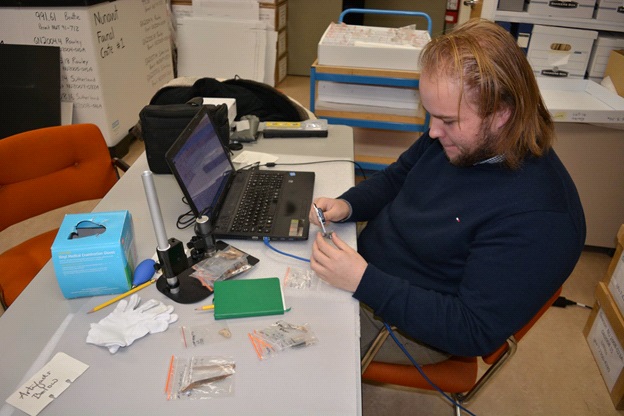
Figure 1: The author diligently recording measurements at the Prince of Wales Northern Heritage Centre (Yellowknife, NWT, Canada) in December 2016.
First, all known metal objects was planned to be compositionally analysed using a portable X-Ray Fluorescence spectrometer (pXRF). The pXRF would essentially non-destructively give composition data from the existing metal tools in Late Dorset contexts which would help determine the source of any given object. Second, the blade slot thickness on a large sample of organic tools (e.g. harpoon heads or knife handles) was measured with a set of calipers. Additionally, existing lithic and metal blades were also measured around their hafting location. Both measurements taken together can potentially illuminate if an organic object once held a metal (generally considered thinner) or a stone (generally considered thicker) blade. In order to statistically test the blade slot results against other attributes of the artefacts, a number of other measurements as well as presence/absence notes were taken for a number of other aspects of the organic objects. Third, the blade slot of all organic objects was closely observed under a microscope in hopes of identifying any residues left behind by a metal blade on the organic object (e.g. iron oxide “rust”) that might not be visible by the naked eye. Unfortunately, due to factors far beyond my own control the pXRF portion of this project was not able to be completed. While this reduces the overall scope of the results, the data collected by the other two methods are significant in their own right and still address the major aims of this project.
The entire project was generously funded by two sources. The Wenner-Gren Foundation provided the bulk of the research funds, supporting travel, accommodation, and some equipment costs. The Royal Anthropological Institute’s Emslie Horniman Scholarship funded the purchase of a Dinolite portable digital microscope, representing the third portion of the methodology discussed above.
Preliminary Results
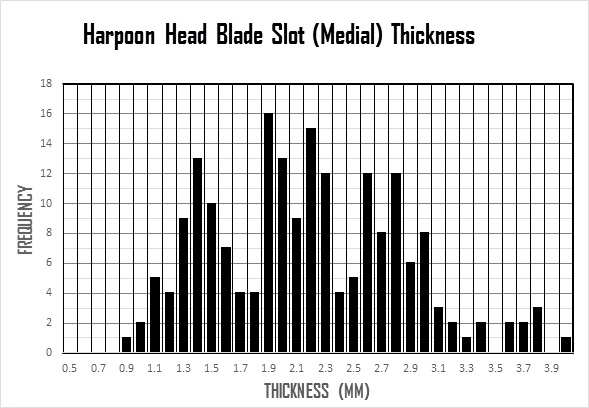
Figure 2: Harpoon head blade slot thickness measurements.
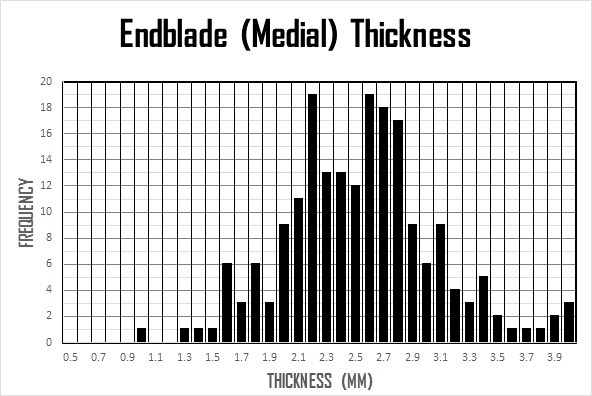
Figure 3: Endblade thickness measurements (N.B. Only 4 are metal endblades).
Results from the blade slot measurements and microscopy are still being analysed. In total, 201 harpoon heads and 426 lithic or metal endblades (i.e. artefacts identified as blades that would have been hafted in a harpoon head) were sampled. Importantly, many other organic artefacts and lithic blade types were sampled but the data presented here represents the first batch of visualised data. Figure 2 shows the thickness of harpoon head blade slots taken from a medial position along the blade bed. As what can be clearly seen, a trimodal distribution was produced with modes occurring around 1.4mm, 2.0mm, and 2.6mm. When compared with the blade thickness measurements taken off of stone, metal, and organic blades a similar distribution is not observed (Figure 3). Instead what is seen is a normal distribution curve with the mean, median, and mode centering around 2.6mm. Additionally, there are a number of specimens which measured +/- 0.2mm around the 2.0mm mark. What is not observed in any sizeable number are stone blades which cluster around the 1.4mm (+/- 0.2mm) mark. While further analysis must be carried out and the significance of these results must be determined, primary indications demonstrate a large sample of harpoon head blade slots which are too thin to carry any of the recorded stone blades aside from a handful of outliers.
Each of the 201 harpoon heads included in blade slot measurement dataset was observed under a microscope to identify potential residues left behind by a metal blade. Furthermore, all other harpoon heads identified in relevant sites but were not included in the blade slot measurements due to poor preservation of both blade beds were also observed under a microscope. Identifiable residues were then photographed by the microscope. While formal quantification and analysis of the microscopy results is still underway, a number of harpoon heads had residues located on their blade slots which may have been left by a metal blade. Some objects were previously identified by past researchers as having iron oxide stains (Figure 4) but these were all done without the aid of a microscope, leaving a large body of objects not analysed. Figures 5 and 6 demonstrate two harpoon heads that have possible and likely iron oxide staining. These residues were technically visible with the naked eye but formal identification would not be possible without the aid of a microscope. Caution in interpreting these results must be emphasised and closer inspection is required as a number of other potential causes for those stains may exist. First, a number of organic and stone objects had identifiable red ochre residue on them (Figure 7). Second, naturally occurring iron is found in some Arctic soils and can potentially stain both organic and lithic artefacts. Third, a number of discolourations were noted on organic objects which were most likely related to the organic material itself (Figure 8). Fourth, potentially the Late Dorset used adhesives to secure blades in harpoon heads or knife handles and, while no published research has looked at that possibility, the residues left behind may resemble that left behind by an iron or copper blade. In total, understanding if a stain identified under the microscope represents an iron or copper blade being hafted in an organic object or perhaps something else entirely is an important question that requires further analysis of the available data. In any case, a number of such residues were identified on organic specimens and it seems likely that a number of those residues would represent staining from contact with a metal blade.
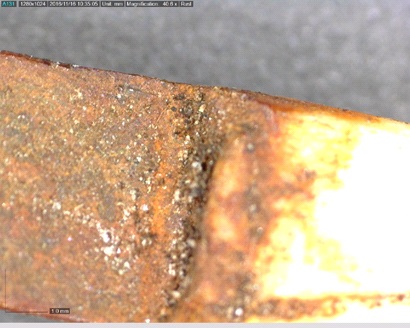
Figure 4: Knife handle (SgFm 5:57) with iron oxide stains visible to the naked eye.
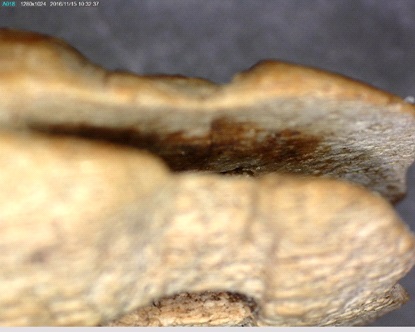
Figure 5: Harpoon head (SgFm 3:335) with possible iron oxide stains on blade bed.
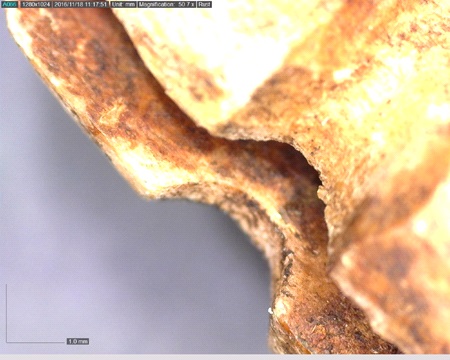
Figure 6: Harpoon head (SiFi 4:92) with likely iron oxide stains on blade bed.
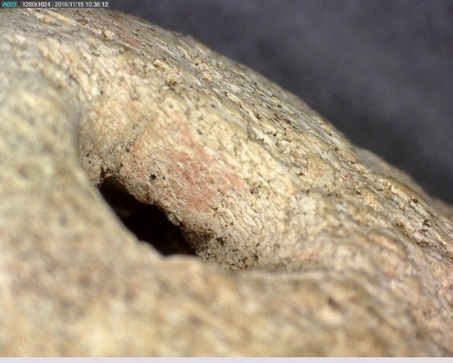
Figure 7: Securing hole of a harpoon head (SgFm3:349) with potential red ochre residue not identifiable with the naked eye.
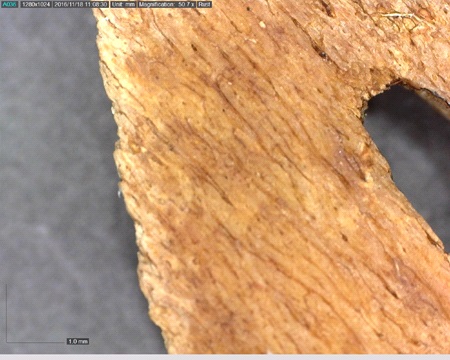
Figure 8: Harpoon head (SiFi4:93) blade bed with natural brown discolourations.
Discussion
Ultimately, there are only a few possible solutions for this. First, it is possible that organic harpoon heads were prepared by having the blade slot soak in water before attaching a blade. This would make the slot soft and might result in a number of thinner blade slots being stretched to fit a thicker stone blade. Second, there is a collection bias with past excavations and the smaller, thinner stone blades were not collected due to past excavation methodology. Third, the thin blade slots would have been fitted with a metal blade and the corresponding lack of recovered metal blades in the archaeological record is a results of either poor preservation or object curation on the part of the Late Dorset. In other words, curation would lead to a far smaller number of metal blades versus the number of harpoon head slots that supported them. While only an experimental archaeology programme could engage with the first possibility, the second possibility seems the least likely. In particular, most of the stone artefacts that are recovered in Arctic sites are already incredibly small. Moreover, the vast majority of the sites had a large collection of debitage (i.e. stone tool manufacturing waste) that was also collected. It seems unlikely, given those facts, that a very specific artefact type would not be recovered yet smaller pieces of debitage would be. The final solution seems the most likely given the present data. Unfortunately, without primary data or further excavation, assessing whether the Late Dorset were curating and reusing their metal blades or if it is a factor of the acidic Arctic soils, it will not be definitively known. Importantly, metal detectors have not been frequently used in past Arctic excavations. When they have been used, a larger than normal amount of metal has been recovered (e.g. LeMoine et al. 2003). While this cannot prove definitively that poor preservation is the cause for the lack of metal objects, it does indicate that perhaps metal was used far more than what the current assemblage suggests. Coupling those results with the data presented here and our understanding of how much metal the Late Dorset used and what that can tell us about exchange networks in the ancient Arctic is becoming clearer. Lastly, the potential oxide residues identified through the microscopy portion of this project will offer a way for checking the blade slot results. Additionally, it has given a chance to broaden the results as objects without a fully surviving blade bed can be assessed if they potentially held a metal blade. While all these data require a substantial amount of further analysis, the preliminary results are promising. It must be emphasised that further comparison of these data with other recorded attributes as well as a full spatial and, when available, temporal comparison will be undertaken which will enrich the results far beyond what is presented in this preliminary summary. Importantly, these data will be used to answer questions much broader than simply assessing metal use but will begin to consider the implications of the exchange of metal and how that may have shaped or was shaped by Late Dorset social networks.
Significance to Anthropology
This study represents the first Pan-Arctic attempt to understand Late Dorset metal use. Overall, the research that the Royal Anthropological Institute funded is shaping up to be incredibly promising. The data collected has already opened up a new dimension into understanding early Arctic metal use and, after further assessment, will bring a level of discourse not yet seen concerning this subject in the Arctic. Ultimately, this research will engage with a number of subjects relevant to anthropologists and archaeologists regarding ways in which the people viewed and exchanged metal objects and the way they were able to establish networks that spanned not only space, as evidenced by the exchange of the metal, but also time, as noted by the artefacts potentially being curated.
References
Cooper, K. 2016. Arctic Archaeometallurgy. In Friesen and Mason (eds) 2016. Pp. 176-196.
Ehrenreich, R. (ed). 1991. Metals in Society. Philadelphia, MASCA.
Franklin, U., E. Badone, R. Gotthardt, and B. Yorga. 1981. An Examination of Prehistoric Copper Technology and Copper Sources in Western Arctic and Subarctic Canada. Ottawa, National Museum of Man.
Friesen, M., and Mason, O. (eds). 2016. The Oxford Handbook of the Prehistoric Arctic. Oxford, University of Oxford Press.
Gullason, L. 1999. Engendering Interaction: Inuit-European Contact in Frobisher Bay, Baffin Island. Unpublished PhD Thesis, McGill University.
Grønnow, B., Gotfredsen, A., Myrup, M., and Appelt, M. 2014. Aspects of Past Life at the North Water. Technical Report. In The NOW Project: Living Resources and Human Societies around the North Water in the Thule Area, NW Greenland. Copenhagen, National Museum of Denmark. Pp. 3-18.
Jensen, J., Appelt, M., and Myrup, M. 2015. Himmelsk og jordisk jern I Grønlands forhistorie – ny teknologi og gamle problemer. Copenhagen, National Museum of Denmark.
LeMoine, G., Helmer, J., and Gronnow, B. 2003. Late Dorset Architecture on Little Cornwallis Island. Inuit Studies 27 (1-2): 255-280.
Maschner, H., Mason, O., and McGhee, R. (eds). 2009. The Northern World AD 900-1400. Salt Lake City, University of Utah Press.Ryan, K. 2016. The “Dorset Problem” Revisted: The Transitional and Early and Middle Dorset Periods in the Eastern Arctic. In Friesen and Mason (eds) 2016. Pp. 762-782.
McCartney, A. 1991. Canadian Arctic Trade Metal: Reflections of Prehistoric to Historic Social Networks. In: Ehrenreich (ed) 1991. Pp. 26-43.
Schledermann, P. 1990. Crossroads to Greenland. Calgary, The Arctic Institute of North America.
Sutherland, P. 2009. The Question of Contact between Dorset Paleo-Eskimos and Early Europeans in the Eastern Arctic. In: Maschner et al. (eds) 2009. Pp. 279-299.
Sutherland, P. and Thompson, P. 2016. Material and Meaning: Honing in on the Avayalik Islands. Paper presented at the 2016 Canadian Archaeological Association Annual Meeting in Whitehorse, Yukon.
Sutherland, P., Thompson, P., and Hunt, P. 2014. Evidence of Early Metalworking in Arctic Canada. Geoarchaeology 30: 74-78.
Whitridge, P. 2002. Gender, Households, and the Material Construction of Social Difference. In Frink et al. (eds) 2002. Pp. 165-191.

